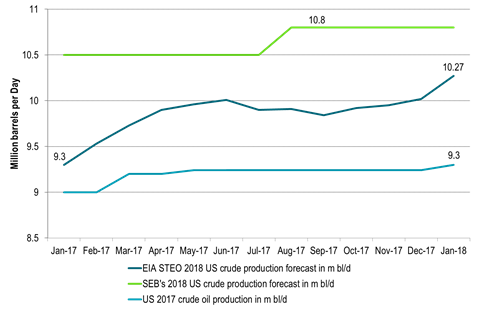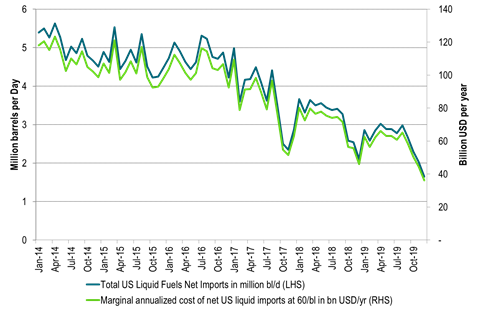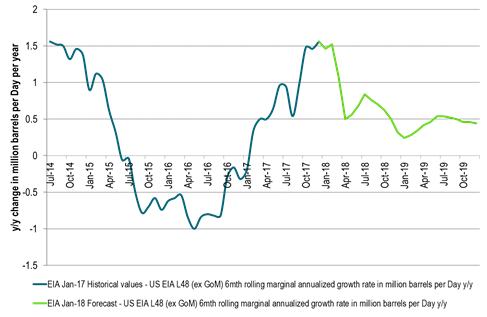Analys
OPEC calls for sub-$60/bl but market heads for $70/bl, while US oil production is steaming ahead

 Iran’s oil minister Zanganeh yesterday intervened verbally in the oil market by stating that OPEC’s members do not want Brent crude oil above $60/bl because of shale oil. The market could not care less and instead jumped 1.5% to $68.82/bl totally forgetting and disregarding that the current deficit and inventory draw down is artificially mastered by OPEC & Co. Later in the day the US EIA revised its US crude oil production 2018 forecast up by 250 k bl/d to 10.27 m bl/d. Still too low in our view. Later today we’ll have the US oil inventories for which the API yesterday predicted a huge crude oil draw of 11.2 m bl. Brent crude is trading bullishly at $69.2/bl (+0.6%) and ready to take the jump above the 2015 high of $69.63/b and potentially touch $70/bl. US crude oil production is growing and growing to the increasing concern of OPEC & Co and their verbal intervention has started. Producers should listen carefully and take good care of their downside risks.
Iran’s oil minister Zanganeh yesterday intervened verbally in the oil market by stating that OPEC’s members do not want Brent crude oil above $60/bl because of shale oil. The market could not care less and instead jumped 1.5% to $68.82/bl totally forgetting and disregarding that the current deficit and inventory draw down is artificially mastered by OPEC & Co. Later in the day the US EIA revised its US crude oil production 2018 forecast up by 250 k bl/d to 10.27 m bl/d. Still too low in our view. Later today we’ll have the US oil inventories for which the API yesterday predicted a huge crude oil draw of 11.2 m bl. Brent crude is trading bullishly at $69.2/bl (+0.6%) and ready to take the jump above the 2015 high of $69.63/b and potentially touch $70/bl. US crude oil production is growing and growing to the increasing concern of OPEC & Co and their verbal intervention has started. Producers should listen carefully and take good care of their downside risks.
Zanganeh’s statement should not be taken lightly by the market. The market seems to forget that a key reason for why we have had an 18% y/y (to 29 Dec 2017) bull-rally in the oil market was because OPEC & Co held back a significant amount of supply and still are. It has thus been an artificially mastered bull-market by the hands of OPEC & Co. The draw-down of global inventories has of course been real but it has been a mastered draw-down at the will of OPEC & Co and it still is.
If OPEC & Co deems the oil price too high and the US crude oil production growth too strong then they can and will do something about it. Yesterday we saw the first step of verbal intervention. Expect more of the same to come. And if the market refuses to listen then they will put more supply into the market.
The market is just happy that oil prices are rising. Global economic growth is accelerating, oil demand growth is very strong, inventories are drawing down and oil prices are naturally rising as a result. The oil market does of course have good reason to be positive about the current strong oil demand growth. It has definitely taken the oil market out of the woods so to speak with the Brent 1mth contract now trading at a premium of $9.6/bl over the three year contract. A part of that is strong global oil demand growth. A large part is however OPEC & Co.
The US EIA yesterday revised US crude oil production for 2018 up by 250 k bl/d to 10.27 m bl/d. That was the fourth revision higher in four months. We still think it is too low with more revisions higher to come and we think that everyone are probably able to see this with just a half eye open.
Last year US crude oil production from Lower 48 states (ex GoM) increased 105 k bl/d/mth on average with a total Dec-16 to Dec-17 increase of 1.26 m bl/d. The average monthly growth rate from July to December 2017 was 130 k bl/d/mth which is equal to a marginal annualized growth rate of 1.6 m bl/d.
In December 2017 the US EIA estimated that US shale oil production would likely growth by 94 k bl/d from Dec-17 to Jan-18 thus exiting 2017 at a solid 1.1 m bl/d marginal annualized pace. Last year’s shale oil activity was much about drilling with fracking and completion substantially trailing the drilling activity leading to a huge build-up in DUCs (uncompleted wells). For the year to come we’ll likely see a shift towards completions of these wells and less focus on the drilling of new oil wells. As such we will likely see that completions of wells actually increase some 20% y/y to 2018 while drilling activity falls back by 20%. All in all we are likely to see more well completions in 2018 than in 2017 and not less.
Despite of this the US EIA predicts that US L48 (ex GoM) will only growth at 0.5 m bl/d from Dec-17 to Dec-18 with a monthly pace of only 42 k bl/d/mth. However, if US L48 (ex GoM) grows like it did in 2017 (+105 k bl/d/mth) then total US crude oil production is will average 10.65 m bl/d in 2018. If L48 (ex GoM) instead continues to grow like it did in 2H17 (+130 k bl/d/mth), then total US crude oil production will average 10.8 m bl/d in 2018. All told the US EIA has more upwards revisions to do in the months to come for 2018 US crude oil production forecast.
Chart 1: US crude oil production for 2017 and 2018
Chart 2: US net hydro carbon liquids imports (EIA) and the implied trade balance impact in billion USD at an oil price of $60/bl (SEB)
Chart 3: US 6mths rolling marginal annualized growth in US L48 (ex GoM) in m bl/d (EIA)
Ending the year at a very strong marginal growth rate of 1.6 m b/d. Then very soft in 2018 in the face of higher prices, bullish market sentiment and increasing well completions. Why this soft outlook?
Kind regards
Bjarne Schieldrop
Chief analyst, Commodities
SEB Markets
Merchant Banking
Analys
Tightening fundamentals – bullish inventories from DOE

The latest weekly report from the US DOE showed a substantial drawdown across key petroleum categories, adding more upside potential to the fundamental picture.

Commercial crude inventories (excl. SPR) fell by 5.8 million barrels, bringing total inventories down to 415.1 million barrels. Now sitting 11% below the five-year seasonal norm and placed in the lowest 2015-2022 range (see picture below).
Product inventories also tightened further last week. Gasoline inventories declined by 2.1 million barrels, with reductions seen in both finished gasoline and blending components. Current gasoline levels are about 3% below the five-year average for this time of year.
Among products, the most notable move came in diesel, where inventories dropped by almost 4.1 million barrels, deepening the deficit to around 20% below seasonal norms – continuing to underscore the persistent supply tightness in diesel markets.
The only area of inventory growth was in propane/propylene, which posted a significant 5.1-million-barrel build and now stands 9% above the five-year average.
Total commercial petroleum inventories (crude plus refined products) declined by 4.2 million barrels on the week, reinforcing the overall tightening of US crude and products.


Analys
Bombs to ”ceasefire” in hours – Brent below $70

A classic case of “buy the rumor, sell the news” played out in oil markets, as Brent crude has dropped sharply – down nearly USD 10 per barrel since yesterday evening – following Iran’s retaliatory strike on a U.S. air base in Qatar. The immediate reaction was: “That was it?” The strike followed a carefully calibrated, non-escalatory playbook, avoiding direct threats to energy infrastructure or disruption of shipping through the Strait of Hormuz – thus calming worst-case fears.

After Monday morning’s sharp spike to USD 81.4 per barrel, triggered by the U.S. bombing of Iranian nuclear facilities, oil prices drifted sideways in anticipation of a potential Iranian response. That response came with advance warning and caused limited physical damage. Early this morning, both the U.S. President and Iranian state media announced a ceasefire, effectively placing a lid on the immediate conflict risk – at least for now.
As a result, Brent crude has now fallen by a total of USD 12 from Monday’s peak, currently trading around USD 69 per barrel.
Looking beyond geopolitics, the market will now shift its focus to the upcoming OPEC+ meeting in early July. Saudi Arabia’s decision to increase output earlier this year – despite falling prices – has drawn renewed attention considering recent developments. Some suggest this was a response to U.S. pressure to offset potential Iranian supply losses.
However, consensus is that the move was driven more by internal OPEC+ dynamics. After years of curbing production to support prices, Riyadh had grown frustrated with quota-busting by several members (notably Kazakhstan). With Saudi Arabia cutting up to 2 million barrels per day – roughly 2% of global supply – returns were diminishing, and the risk of losing market share was rising. The production increase is widely seen as an effort to reassert leadership and restore discipline within the group.
That said, the FT recently stated that, the Saudis remain wary of past missteps. In 2018, Riyadh ramped up output at Trump’s request ahead of Iran sanctions, only to see prices collapse when the U.S. granted broad waivers – triggering oversupply. Officials have reportedly made it clear they don’t intend to repeat that mistake.
The recent visit by President Trump to Saudi Arabia, which included agreements on AI, defense, and nuclear cooperation, suggests a broader strategic alignment. This has fueled speculation about a quiet “pump-for-politics” deal behind recent production moves.
Looking ahead, oil prices have now retraced the entire rally sparked by the June 13 Israel–Iran escalation. This retreat provides more political and policy space for both the U.S. and Saudi Arabia. Specifically, it makes it easier for Riyadh to scale back its three recent production hikes of 411,000 barrels each, potentially returning to more moderate increases of 137,000 barrels for August and September.
In short: with no major loss of Iranian supply to the market, OPEC+ – led by Saudi Arabia – no longer needs to compensate for a disruption that hasn’t materialized, especially not to please the U.S. at the cost of its own market strategy. As the Saudis themselves have signaled, they are unlikely to repeat previous mistakes.
Conclusion: With Brent now in the high USD 60s, buying oil looks fundamentally justified. The geopolitical premium has deflated, but tensions between Israel and Iran remain unresolved – and the risk of missteps and renewed escalation still lingers. In fact, even this morning, reports have emerged of renewed missile fire despite the declared “truce.” The path forward may be calmer – but it is far from stable.
Analys
A muted price reaction. Market looks relaxed, but it is still on edge waiting for what Iran will do

Brent crossed the 80-line this morning but quickly fell back assigning limited probability for Iran choosing to close the Strait of Hormuz. Brent traded in a range of USD 70.56 – 79.04/b last week as the market fluctuated between ”Iran wants a deal” and ”US is about to attack Iran”. At the end of the week though, Donald Trump managed to convince markets (and probably also Iran) that he would make a decision within two weeks. I.e. no imminent attack. Previously when when he has talked about ”making a decision within two weeks” he has often ended up doing nothing in the end. The oil market relaxed as a result and the week ended at USD 77.01/b which is just USD 6/b above the year to date average of USD 71/b.

Brent jumped to USD 81.4/b this morning, the highest since mid-January, but then quickly fell back to a current price of USD 78.2/b which is only up 1.5% versus the close on Friday. As such the market is pricing a fairly low probability that Iran will actually close the Strait of Hormuz. Probably because it will hurt Iranian oil exports as well as the global oil market.
It was however all smoke and mirrors. Deception. The US attacked Iran on Saturday. The attack involved 125 warplanes, submarines and surface warships and 14 bunker buster bombs were dropped on Iranian nuclear sites including Fordow, Natanz and Isfahan. In response the Iranian Parliament voted in support of closing the Strait of Hormuz where some 17 mb of crude and products is transported to the global market every day plus significant volumes of LNG. This is however merely an advise to the Supreme leader Ayatollah Ali Khamenei and the Supreme National Security Council which sits with the final and actual decision.
No supply of oil is lost yet. It is about the risk of Iran closing the Strait of Hormuz or not. So far not a single drop of oil supply has been lost to the global market. The price at the moment is all about the assessed risk of loss of supply. Will Iran choose to choke of the Strait of Hormuz or not? That is the big question. It would be painful for US consumers, for Donald Trump’s voter base, for the global economy but also for Iran and its population which relies on oil exports and income from selling oil out of that Strait as well. As such it is not a no-brainer choice for Iran to close the Strait for oil exports. And looking at the il price this morning it is clear that the oil market doesn’t assign a very high probability of it happening. It is however probably well within the capability of Iran to close the Strait off with rockets, mines, air-drones and possibly sea-drones. Just look at how Ukraine has been able to control and damage the Russian Black Sea fleet.
What to do about the highly enriched uranium which has gone missing? While the US and Israel can celebrate their destruction of Iranian nuclear facilities they are also scratching their heads over what to do with the lost Iranian nuclear material. Iran had 408 kg of highly enriched uranium (IAEA). Almost weapons grade. Enough for some 10 nuclear warheads. It seems to have been transported out of Fordow before the attack this weekend.
The market is still on edge. USD 80-something/b seems sensible while we wait. The oil market reaction to this weekend’s events is very muted so far. The market is still on edge awaiting what Iran will do. Because Iran will do something. But what and when? An oil price of 80-something seems like a sensible level until something do happen.
-

 Nyheter3 veckor sedan
Nyheter3 veckor sedanStor uppsida i Lappland Guldprospekterings aktie enligt analys
-

 Nyheter4 veckor sedan
Nyheter4 veckor sedanBrookfield ska bygga ett AI-datacenter på hela 750 MW i Strängnäs
-

 Nyheter3 veckor sedan
Nyheter3 veckor sedanSilverpriset släpar efter guldets utveckling, har mer uppsida
-

 Nyheter4 veckor sedan
Nyheter4 veckor sedanTradingfirman XTX Markets bygger datacenter i finska Kajana för 1 miljard euro
-

 Nyheter2 veckor sedan
Nyheter2 veckor sedanUppgången i oljepriset planade ut under helgen
-

 Nyheter2 veckor sedan
Nyheter2 veckor sedanLåga elpriser i sommar – men mellersta Sverige får en ökning
-

 Analys2 veckor sedan
Analys2 veckor sedanVery relaxed at USD 75/b. Risk barometer will likely fluctuate to higher levels with Brent into the 80ies or higher coming 2-3 weeks
-

 Nyheter1 vecka sedan
Nyheter1 vecka sedanMahvie Minerals växlar spår – satsar fullt ut på guld












